Entrepreneurship & Small Business: B&M Company Analysis Report
VerifiedAdded on 2023/01/12
|16
|4480
|45
Report
AI Summary
This report provides a comprehensive analysis of entrepreneurial ventures, using B&M Company as a case study. It explores different types of entrepreneurial ventures, including social, scalable, large company, and small business ventures, and their relationship with typologies of entrepreneurship such as lifestyle, survival, managed growth, and aggressive growth ventures. The report also discusses the similarities and differences among these ventures and examines the impact of micro and small businesses on the economy, particularly in the context of the United Kingdom. Furthermore, it highlights the importance of small businesses and start-ups on the growth of the social economy and identifies the key characteristics, traits, and skills of successful entrepreneurs. Finally, the report touches upon how different environments can either hinder or foster entrepreneurship. This student-contributed report is available on Desklib, where students can find similar solved assignments and past papers.
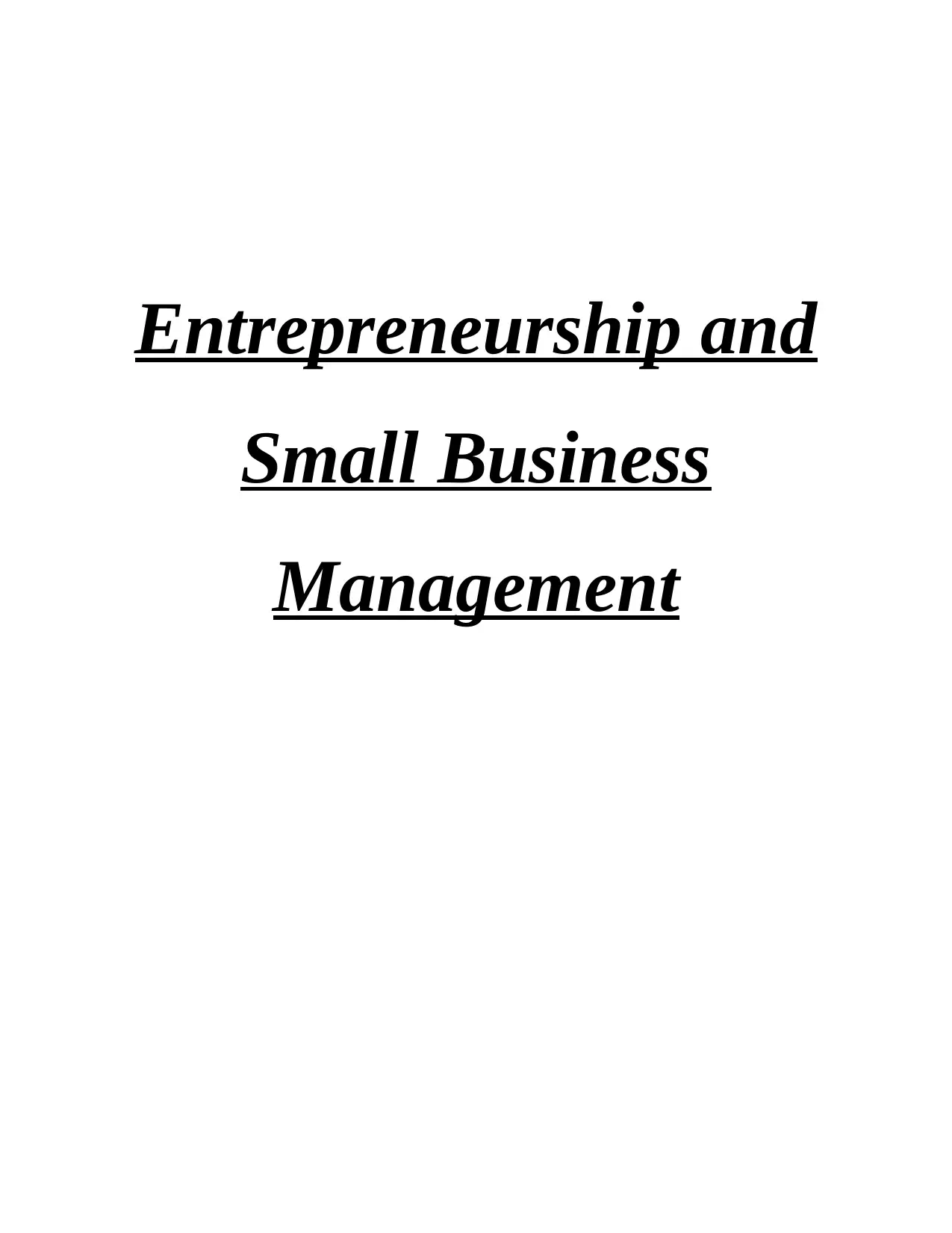
Entrepreneurship and
Small Business
Management
Small Business
Management
Paraphrase This Document
Need a fresh take? Get an instant paraphrase of this document with our AI Paraphraser
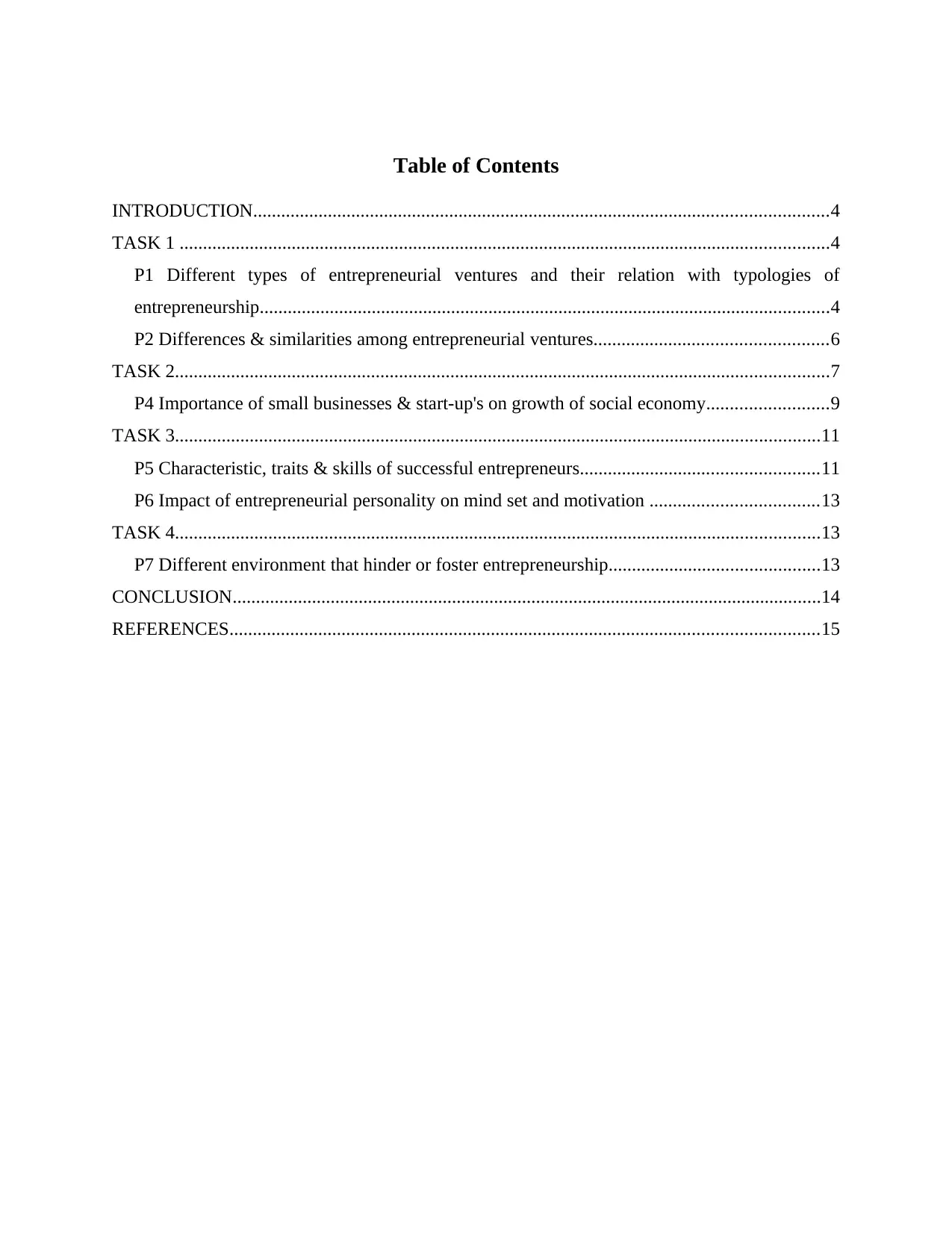
Table of Contents
INTRODUCTION...........................................................................................................................4
TASK 1 ...........................................................................................................................................4
P1 Different types of entrepreneurial ventures and their relation with typologies of
entrepreneurship..........................................................................................................................4
P2 Differences & similarities among entrepreneurial ventures..................................................6
TASK 2............................................................................................................................................7
P4 Importance of small businesses & start-up's on growth of social economy..........................9
TASK 3..........................................................................................................................................11
P5 Characteristic, traits & skills of successful entrepreneurs...................................................11
P6 Impact of entrepreneurial personality on mind set and motivation ....................................13
TASK 4..........................................................................................................................................13
P7 Different environment that hinder or foster entrepreneurship.............................................13
CONCLUSION..............................................................................................................................14
REFERENCES..............................................................................................................................15
INTRODUCTION...........................................................................................................................4
TASK 1 ...........................................................................................................................................4
P1 Different types of entrepreneurial ventures and their relation with typologies of
entrepreneurship..........................................................................................................................4
P2 Differences & similarities among entrepreneurial ventures..................................................6
TASK 2............................................................................................................................................7
P4 Importance of small businesses & start-up's on growth of social economy..........................9
TASK 3..........................................................................................................................................11
P5 Characteristic, traits & skills of successful entrepreneurs...................................................11
P6 Impact of entrepreneurial personality on mind set and motivation ....................................13
TASK 4..........................................................................................................................................13
P7 Different environment that hinder or foster entrepreneurship.............................................13
CONCLUSION..............................................................................................................................14
REFERENCES..............................................................................................................................15

INTRODUCTION
Entrepreneur is a person who launch a new business & is able to bear loss and risk so that
they can generate money in an effective manner. They bring innovative things in order to attain
higher profits and gain success at marketplace (Boodraj and Boodraj, 2017). They convert idea
into products as well as services which assist them to fulfil their needs and requirements.
Entrepreneurship is defined as a procedure of designing, introducing & launching a innovative
product and service at marketplace. The people who implement and execute activities related to
new business is known as entrepreneurs. B&M company is taken into consideration for the
present report. The company was founded by simon & Bobby Arora who is a renowned
entrepreneurs. B&M is famous as homewares chain in the worldwide. The report discusses
different types of entrepreneurial ventures along with the typologies of entrepreneurship. In
addition to this, differences as well as similarities among entrepreneurial ventures is cover in the
present report. Furthermore, there is a discussion regarding the impact of small, micro & large
businesses on national as well as local economy. The key attributes, skills & traits of
entrepreneurs is discuss in the report. Later, the report discusses how background & experience
can foster or hinder entrepreneurship.
TASK 1
P1 Different types of entrepreneurial ventures and their relation with typologies of
entrepreneurship
Entrepreneurial ventures is termed as an entity which places innovation & opportunism at
their heart so that they can develop economic as well as social value. Entrepreneurship is defined
as a procedure where companies are formulated by taking higher risk in order to generate profits.
Entrepreneurial ventures is mainly emphasise on giving advisory service to small and early stage
companies so that they can run business in a smooth manner (Brush and et. al., 2019). There are
mainly four types of entrepreneurial ventures which is mentioned below:
Social Entrepreneurial Venture: Herein, entrepreneurs develop product & services in
order to solve social problems & needs. Their main motive is not to earn profits but to build a
world better place. Social entrepreneurial ventures can be hybrid, profit as well as non-profit. For
instance, safepoint Trust is a social entrepreneurship organisation that launches non-reusable
Entrepreneur is a person who launch a new business & is able to bear loss and risk so that
they can generate money in an effective manner. They bring innovative things in order to attain
higher profits and gain success at marketplace (Boodraj and Boodraj, 2017). They convert idea
into products as well as services which assist them to fulfil their needs and requirements.
Entrepreneurship is defined as a procedure of designing, introducing & launching a innovative
product and service at marketplace. The people who implement and execute activities related to
new business is known as entrepreneurs. B&M company is taken into consideration for the
present report. The company was founded by simon & Bobby Arora who is a renowned
entrepreneurs. B&M is famous as homewares chain in the worldwide. The report discusses
different types of entrepreneurial ventures along with the typologies of entrepreneurship. In
addition to this, differences as well as similarities among entrepreneurial ventures is cover in the
present report. Furthermore, there is a discussion regarding the impact of small, micro & large
businesses on national as well as local economy. The key attributes, skills & traits of
entrepreneurs is discuss in the report. Later, the report discusses how background & experience
can foster or hinder entrepreneurship.
TASK 1
P1 Different types of entrepreneurial ventures and their relation with typologies of
entrepreneurship
Entrepreneurial ventures is termed as an entity which places innovation & opportunism at
their heart so that they can develop economic as well as social value. Entrepreneurship is defined
as a procedure where companies are formulated by taking higher risk in order to generate profits.
Entrepreneurial ventures is mainly emphasise on giving advisory service to small and early stage
companies so that they can run business in a smooth manner (Brush and et. al., 2019). There are
mainly four types of entrepreneurial ventures which is mentioned below:
Social Entrepreneurial Venture: Herein, entrepreneurs develop product & services in
order to solve social problems & needs. Their main motive is not to earn profits but to build a
world better place. Social entrepreneurial ventures can be hybrid, profit as well as non-profit. For
instance, safepoint Trust is a social entrepreneurship organisation that launches non-reusable
⊘ This is a preview!⊘
Do you want full access?
Subscribe today to unlock all pages.

Trusted by 1+ million students worldwide
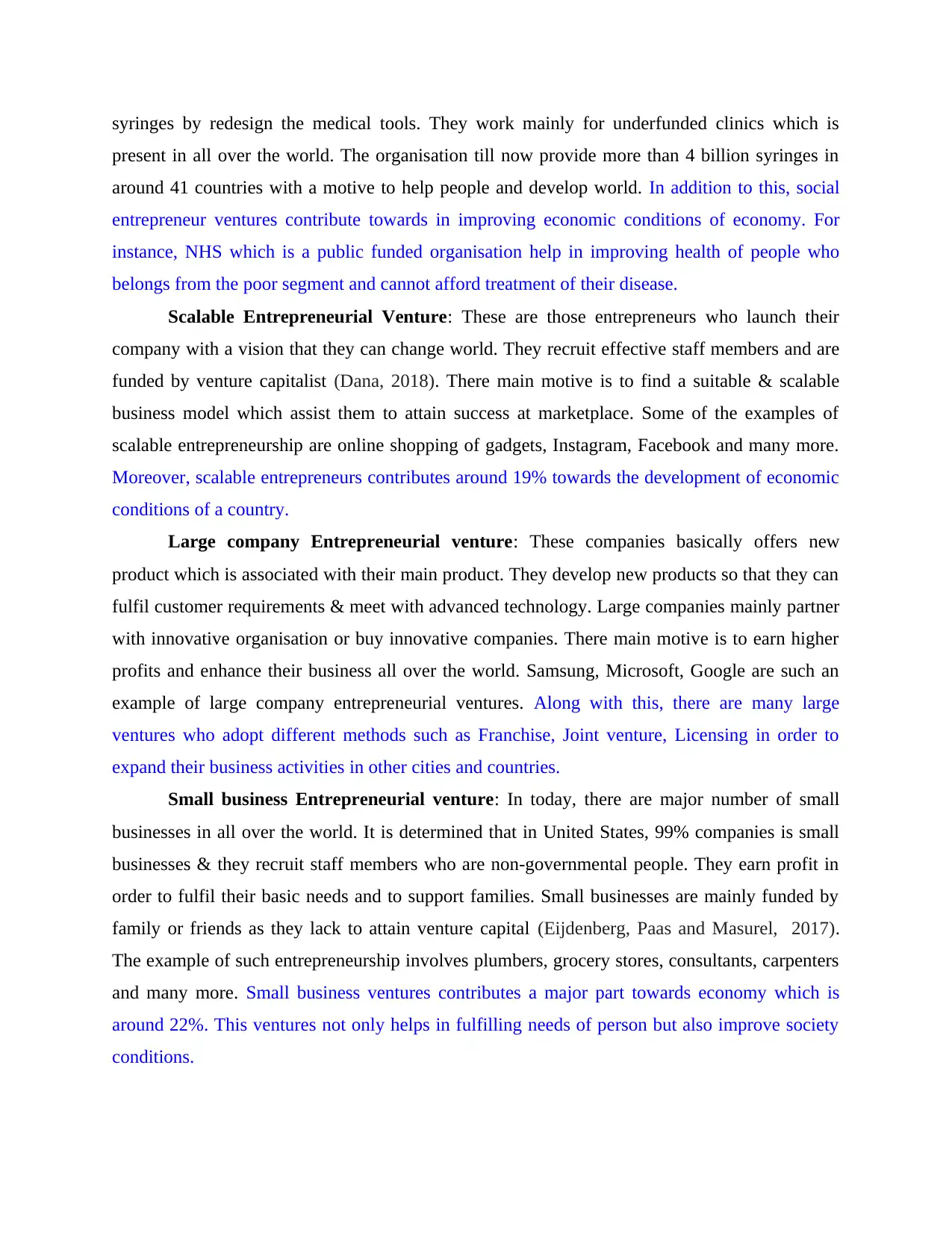
syringes by redesign the medical tools. They work mainly for underfunded clinics which is
present in all over the world. The organisation till now provide more than 4 billion syringes in
around 41 countries with a motive to help people and develop world. In addition to this, social
entrepreneur ventures contribute towards in improving economic conditions of economy. For
instance, NHS which is a public funded organisation help in improving health of people who
belongs from the poor segment and cannot afford treatment of their disease.
Scalable Entrepreneurial Venture: These are those entrepreneurs who launch their
company with a vision that they can change world. They recruit effective staff members and are
funded by venture capitalist (Dana, 2018). There main motive is to find a suitable & scalable
business model which assist them to attain success at marketplace. Some of the examples of
scalable entrepreneurship are online shopping of gadgets, Instagram, Facebook and many more.
Moreover, scalable entrepreneurs contributes around 19% towards the development of economic
conditions of a country.
Large company Entrepreneurial venture: These companies basically offers new
product which is associated with their main product. They develop new products so that they can
fulfil customer requirements & meet with advanced technology. Large companies mainly partner
with innovative organisation or buy innovative companies. There main motive is to earn higher
profits and enhance their business all over the world. Samsung, Microsoft, Google are such an
example of large company entrepreneurial ventures. Along with this, there are many large
ventures who adopt different methods such as Franchise, Joint venture, Licensing in order to
expand their business activities in other cities and countries.
Small business Entrepreneurial venture: In today, there are major number of small
businesses in all over the world. It is determined that in United States, 99% companies is small
businesses & they recruit staff members who are non-governmental people. They earn profit in
order to fulfil their basic needs and to support families. Small businesses are mainly funded by
family or friends as they lack to attain venture capital (Eijdenberg, Paas and Masurel, 2017).
The example of such entrepreneurship involves plumbers, grocery stores, consultants, carpenters
and many more. Small business ventures contributes a major part towards economy which is
around 22%. This ventures not only helps in fulfilling needs of person but also improve society
conditions.
present in all over the world. The organisation till now provide more than 4 billion syringes in
around 41 countries with a motive to help people and develop world. In addition to this, social
entrepreneur ventures contribute towards in improving economic conditions of economy. For
instance, NHS which is a public funded organisation help in improving health of people who
belongs from the poor segment and cannot afford treatment of their disease.
Scalable Entrepreneurial Venture: These are those entrepreneurs who launch their
company with a vision that they can change world. They recruit effective staff members and are
funded by venture capitalist (Dana, 2018). There main motive is to find a suitable & scalable
business model which assist them to attain success at marketplace. Some of the examples of
scalable entrepreneurship are online shopping of gadgets, Instagram, Facebook and many more.
Moreover, scalable entrepreneurs contributes around 19% towards the development of economic
conditions of a country.
Large company Entrepreneurial venture: These companies basically offers new
product which is associated with their main product. They develop new products so that they can
fulfil customer requirements & meet with advanced technology. Large companies mainly partner
with innovative organisation or buy innovative companies. There main motive is to earn higher
profits and enhance their business all over the world. Samsung, Microsoft, Google are such an
example of large company entrepreneurial ventures. Along with this, there are many large
ventures who adopt different methods such as Franchise, Joint venture, Licensing in order to
expand their business activities in other cities and countries.
Small business Entrepreneurial venture: In today, there are major number of small
businesses in all over the world. It is determined that in United States, 99% companies is small
businesses & they recruit staff members who are non-governmental people. They earn profit in
order to fulfil their basic needs and to support families. Small businesses are mainly funded by
family or friends as they lack to attain venture capital (Eijdenberg, Paas and Masurel, 2017).
The example of such entrepreneurship involves plumbers, grocery stores, consultants, carpenters
and many more. Small business ventures contributes a major part towards economy which is
around 22%. This ventures not only helps in fulfilling needs of person but also improve society
conditions.
Paraphrase This Document
Need a fresh take? Get an instant paraphrase of this document with our AI Paraphraser
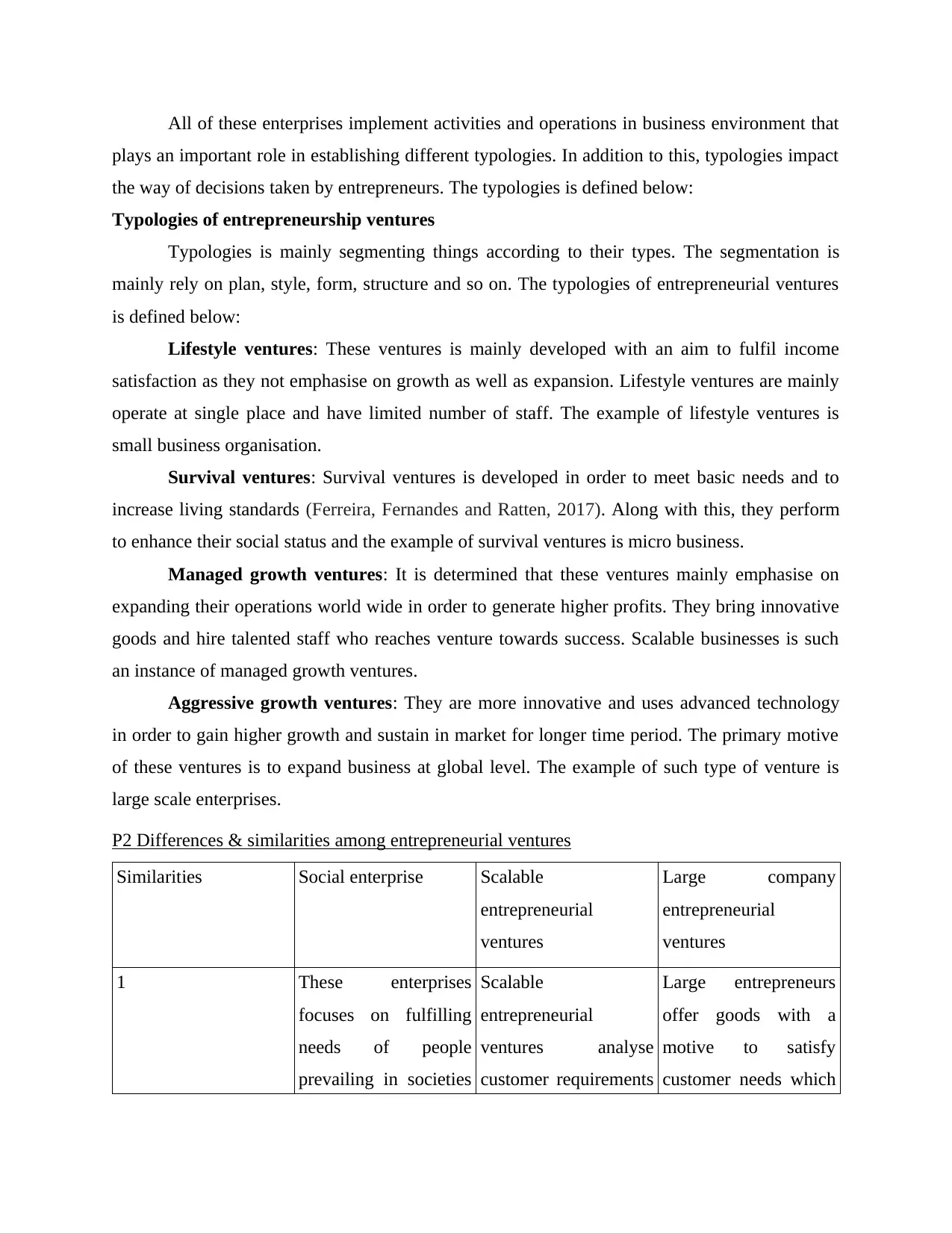
All of these enterprises implement activities and operations in business environment that
plays an important role in establishing different typologies. In addition to this, typologies impact
the way of decisions taken by entrepreneurs. The typologies is defined below:
Typologies of entrepreneurship ventures
Typologies is mainly segmenting things according to their types. The segmentation is
mainly rely on plan, style, form, structure and so on. The typologies of entrepreneurial ventures
is defined below:
Lifestyle ventures: These ventures is mainly developed with an aim to fulfil income
satisfaction as they not emphasise on growth as well as expansion. Lifestyle ventures are mainly
operate at single place and have limited number of staff. The example of lifestyle ventures is
small business organisation.
Survival ventures: Survival ventures is developed in order to meet basic needs and to
increase living standards (Ferreira, Fernandes and Ratten, 2017). Along with this, they perform
to enhance their social status and the example of survival ventures is micro business.
Managed growth ventures: It is determined that these ventures mainly emphasise on
expanding their operations world wide in order to generate higher profits. They bring innovative
goods and hire talented staff who reaches venture towards success. Scalable businesses is such
an instance of managed growth ventures.
Aggressive growth ventures: They are more innovative and uses advanced technology
in order to gain higher growth and sustain in market for longer time period. The primary motive
of these ventures is to expand business at global level. The example of such type of venture is
large scale enterprises.
P2 Differences & similarities among entrepreneurial ventures
Similarities Social enterprise Scalable
entrepreneurial
ventures
Large company
entrepreneurial
ventures
1 These enterprises
focuses on fulfilling
needs of people
prevailing in societies
Scalable
entrepreneurial
ventures analyse
customer requirements
Large entrepreneurs
offer goods with a
motive to satisfy
customer needs which
plays an important role in establishing different typologies. In addition to this, typologies impact
the way of decisions taken by entrepreneurs. The typologies is defined below:
Typologies of entrepreneurship ventures
Typologies is mainly segmenting things according to their types. The segmentation is
mainly rely on plan, style, form, structure and so on. The typologies of entrepreneurial ventures
is defined below:
Lifestyle ventures: These ventures is mainly developed with an aim to fulfil income
satisfaction as they not emphasise on growth as well as expansion. Lifestyle ventures are mainly
operate at single place and have limited number of staff. The example of lifestyle ventures is
small business organisation.
Survival ventures: Survival ventures is developed in order to meet basic needs and to
increase living standards (Ferreira, Fernandes and Ratten, 2017). Along with this, they perform
to enhance their social status and the example of survival ventures is micro business.
Managed growth ventures: It is determined that these ventures mainly emphasise on
expanding their operations world wide in order to generate higher profits. They bring innovative
goods and hire talented staff who reaches venture towards success. Scalable businesses is such
an instance of managed growth ventures.
Aggressive growth ventures: They are more innovative and uses advanced technology
in order to gain higher growth and sustain in market for longer time period. The primary motive
of these ventures is to expand business at global level. The example of such type of venture is
large scale enterprises.
P2 Differences & similarities among entrepreneurial ventures
Similarities Social enterprise Scalable
entrepreneurial
ventures
Large company
entrepreneurial
ventures
1 These enterprises
focuses on fulfilling
needs of people
prevailing in societies
Scalable
entrepreneurial
ventures analyse
customer requirements
Large entrepreneurs
offer goods with a
motive to satisfy
customer needs which
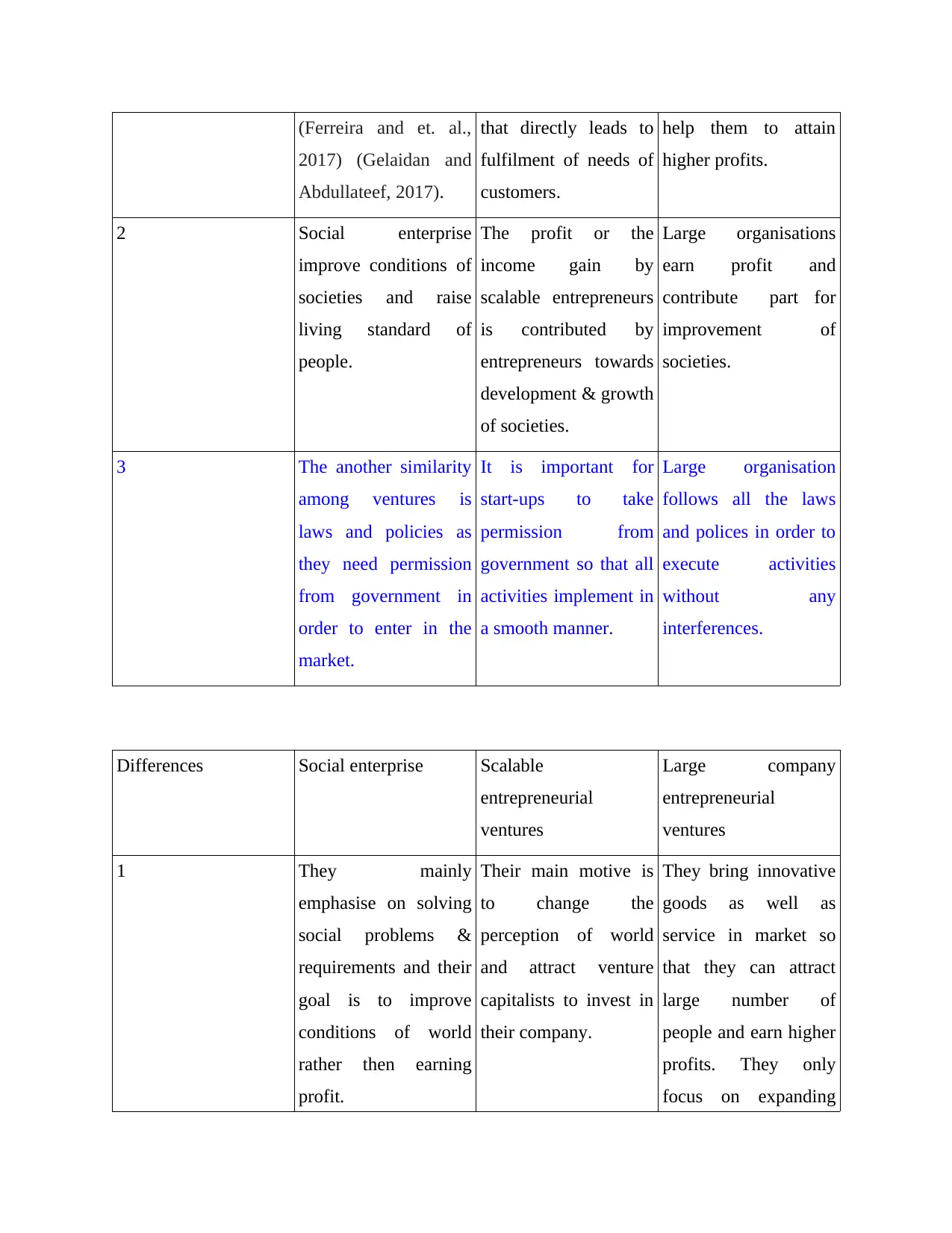
(Ferreira and et. al.,
2017) (Gelaidan and
Abdullateef, 2017).
that directly leads to
fulfilment of needs of
customers.
help them to attain
higher profits.
2 Social enterprise
improve conditions of
societies and raise
living standard of
people.
The profit or the
income gain by
scalable entrepreneurs
is contributed by
entrepreneurs towards
development & growth
of societies.
Large organisations
earn profit and
contribute part for
improvement of
societies.
3 The another similarity
among ventures is
laws and policies as
they need permission
from government in
order to enter in the
market.
It is important for
start-ups to take
permission from
government so that all
activities implement in
a smooth manner.
Large organisation
follows all the laws
and polices in order to
execute activities
without any
interferences.
Differences Social enterprise Scalable
entrepreneurial
ventures
Large company
entrepreneurial
ventures
1 They mainly
emphasise on solving
social problems &
requirements and their
goal is to improve
conditions of world
rather then earning
profit.
Their main motive is
to change the
perception of world
and attract venture
capitalists to invest in
their company.
They bring innovative
goods as well as
service in market so
that they can attract
large number of
people and earn higher
profits. They only
focus on expanding
2017) (Gelaidan and
Abdullateef, 2017).
that directly leads to
fulfilment of needs of
customers.
help them to attain
higher profits.
2 Social enterprise
improve conditions of
societies and raise
living standard of
people.
The profit or the
income gain by
scalable entrepreneurs
is contributed by
entrepreneurs towards
development & growth
of societies.
Large organisations
earn profit and
contribute part for
improvement of
societies.
3 The another similarity
among ventures is
laws and policies as
they need permission
from government in
order to enter in the
market.
It is important for
start-ups to take
permission from
government so that all
activities implement in
a smooth manner.
Large organisation
follows all the laws
and polices in order to
execute activities
without any
interferences.
Differences Social enterprise Scalable
entrepreneurial
ventures
Large company
entrepreneurial
ventures
1 They mainly
emphasise on solving
social problems &
requirements and their
goal is to improve
conditions of world
rather then earning
profit.
Their main motive is
to change the
perception of world
and attract venture
capitalists to invest in
their company.
They bring innovative
goods as well as
service in market so
that they can attract
large number of
people and earn higher
profits. They only
focus on expanding
⊘ This is a preview!⊘
Do you want full access?
Subscribe today to unlock all pages.

Trusted by 1+ million students worldwide
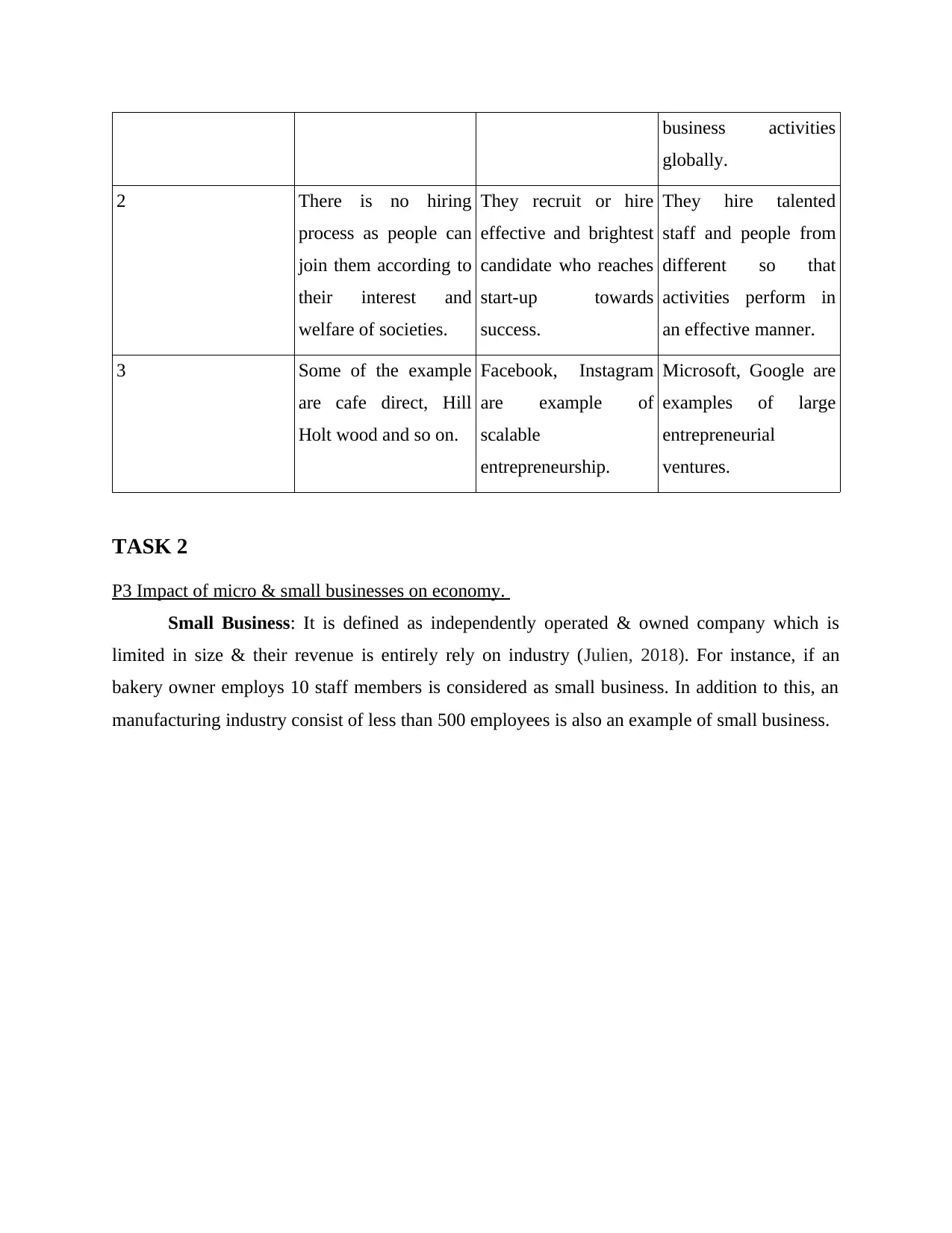
business activities
globally.
2 There is no hiring
process as people can
join them according to
their interest and
welfare of societies.
They recruit or hire
effective and brightest
candidate who reaches
start-up towards
success.
They hire talented
staff and people from
different so that
activities perform in
an effective manner.
3 Some of the example
are cafe direct, Hill
Holt wood and so on.
Facebook, Instagram
are example of
scalable
entrepreneurship.
Microsoft, Google are
examples of large
entrepreneurial
ventures.
TASK 2
P3 Impact of micro & small businesses on economy.
Small Business: It is defined as independently operated & owned company which is
limited in size & their revenue is entirely rely on industry (Julien, 2018). For instance, if an
bakery owner employs 10 staff members is considered as small business. In addition to this, an
manufacturing industry consist of less than 500 employees is also an example of small business.
globally.
2 There is no hiring
process as people can
join them according to
their interest and
welfare of societies.
They recruit or hire
effective and brightest
candidate who reaches
start-up towards
success.
They hire talented
staff and people from
different so that
activities perform in
an effective manner.
3 Some of the example
are cafe direct, Hill
Holt wood and so on.
Facebook, Instagram
are example of
scalable
entrepreneurship.
Microsoft, Google are
examples of large
entrepreneurial
ventures.
TASK 2
P3 Impact of micro & small businesses on economy.
Small Business: It is defined as independently operated & owned company which is
limited in size & their revenue is entirely rely on industry (Julien, 2018). For instance, if an
bakery owner employs 10 staff members is considered as small business. In addition to this, an
manufacturing industry consist of less than 500 employees is also an example of small business.
Paraphrase This Document
Need a fresh take? Get an instant paraphrase of this document with our AI Paraphraser
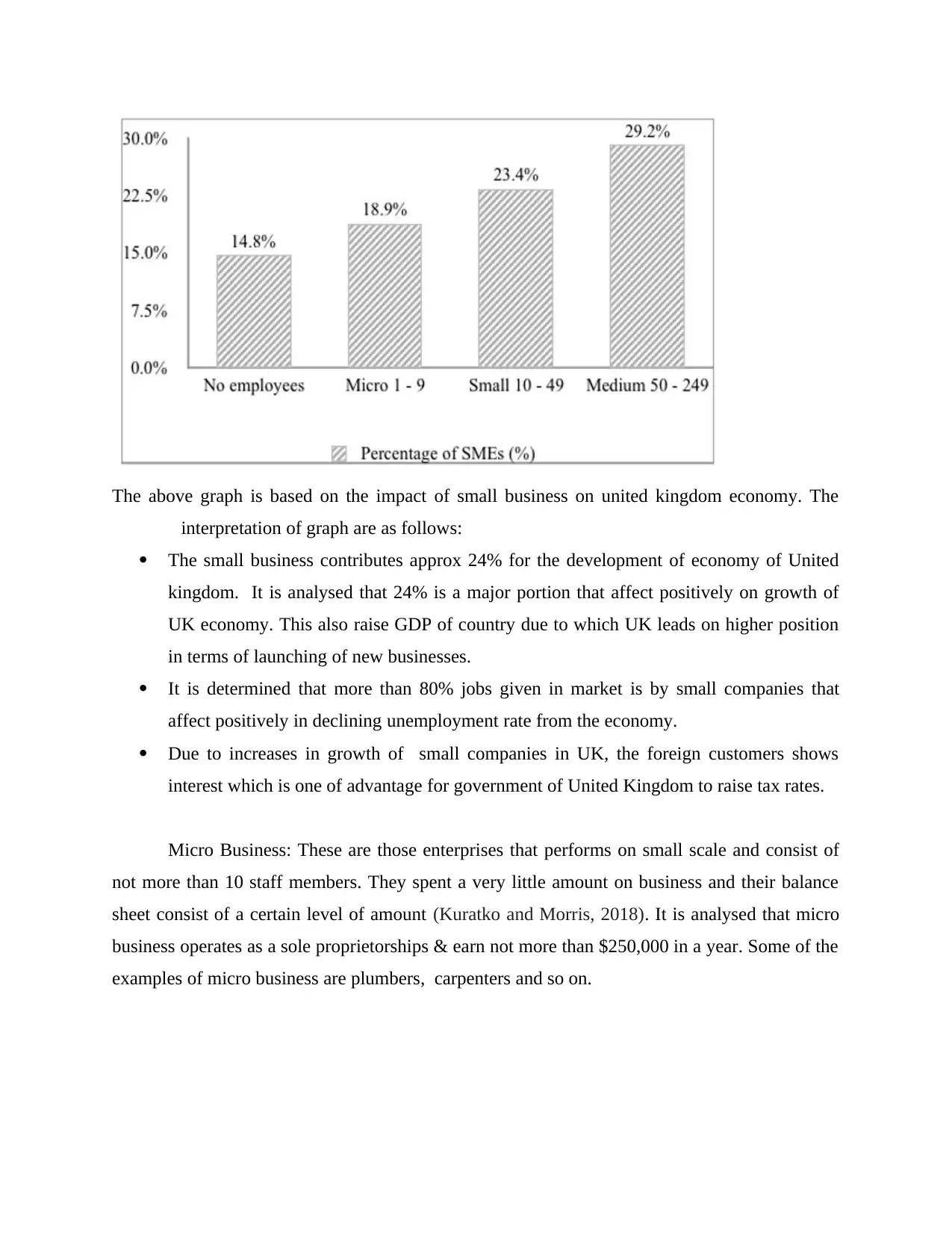
The above graph is based on the impact of small business on united kingdom economy. The
interpretation of graph are as follows:
The small business contributes approx 24% for the development of economy of United
kingdom. It is analysed that 24% is a major portion that affect positively on growth of
UK economy. This also raise GDP of country due to which UK leads on higher position
in terms of launching of new businesses.
It is determined that more than 80% jobs given in market is by small companies that
affect positively in declining unemployment rate from the economy.
Due to increases in growth of small companies in UK, the foreign customers shows
interest which is one of advantage for government of United Kingdom to raise tax rates.
Micro Business: These are those enterprises that performs on small scale and consist of
not more than 10 staff members. They spent a very little amount on business and their balance
sheet consist of a certain level of amount (Kuratko and Morris, 2018). It is analysed that micro
business operates as a sole proprietorships & earn not more than $250,000 in a year. Some of the
examples of micro business are plumbers, carpenters and so on.
interpretation of graph are as follows:
The small business contributes approx 24% for the development of economy of United
kingdom. It is analysed that 24% is a major portion that affect positively on growth of
UK economy. This also raise GDP of country due to which UK leads on higher position
in terms of launching of new businesses.
It is determined that more than 80% jobs given in market is by small companies that
affect positively in declining unemployment rate from the economy.
Due to increases in growth of small companies in UK, the foreign customers shows
interest which is one of advantage for government of United Kingdom to raise tax rates.
Micro Business: These are those enterprises that performs on small scale and consist of
not more than 10 staff members. They spent a very little amount on business and their balance
sheet consist of a certain level of amount (Kuratko and Morris, 2018). It is analysed that micro
business operates as a sole proprietorships & earn not more than $250,000 in a year. Some of the
examples of micro business are plumbers, carpenters and so on.
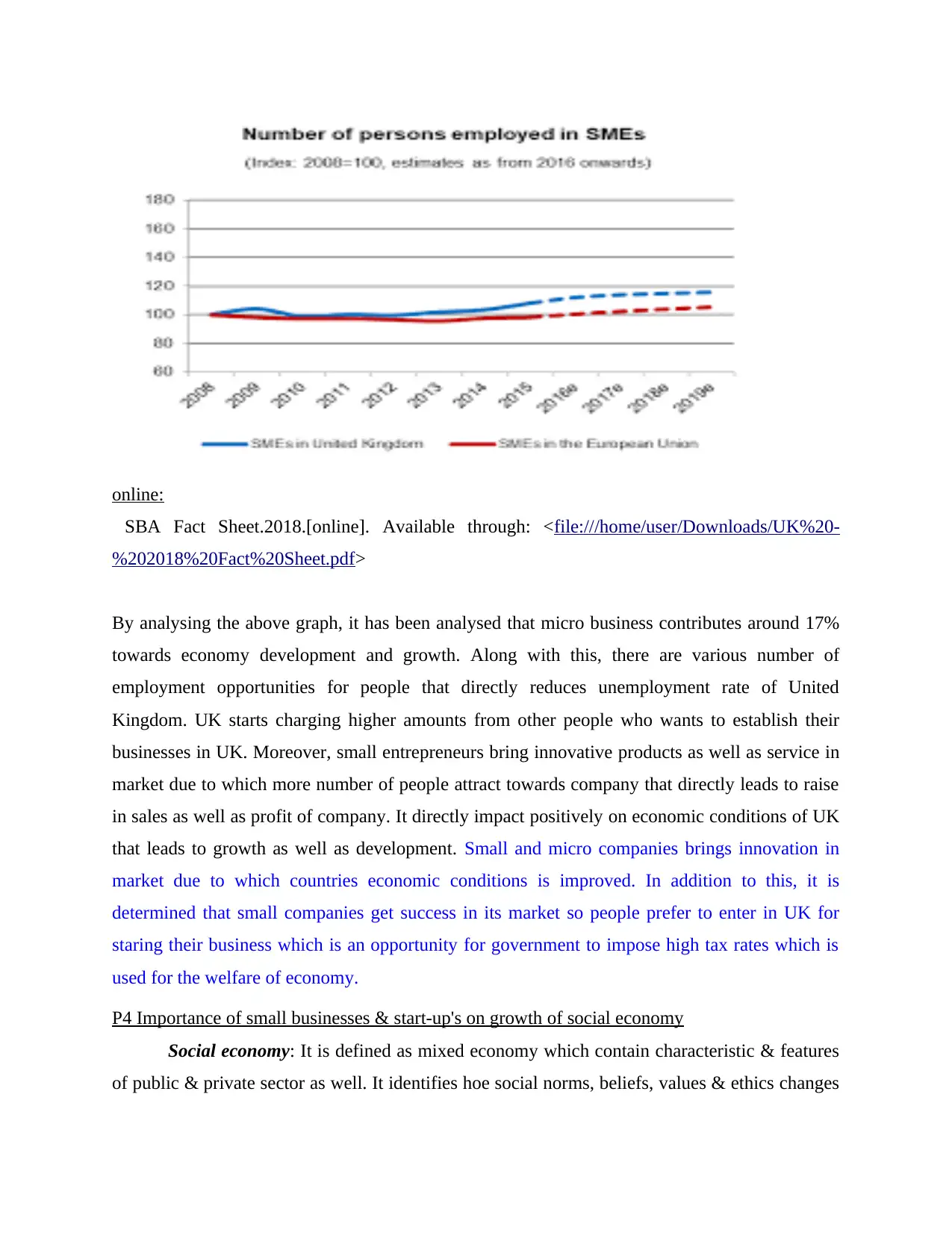
online:
SBA Fact Sheet.2018.[online]. Available through: <file:///home/user/Downloads/UK%20-
%202018%20Fact%20Sheet.pdf>
By analysing the above graph, it has been analysed that micro business contributes around 17%
towards economy development and growth. Along with this, there are various number of
employment opportunities for people that directly reduces unemployment rate of United
Kingdom. UK starts charging higher amounts from other people who wants to establish their
businesses in UK. Moreover, small entrepreneurs bring innovative products as well as service in
market due to which more number of people attract towards company that directly leads to raise
in sales as well as profit of company. It directly impact positively on economic conditions of UK
that leads to growth as well as development. Small and micro companies brings innovation in
market due to which countries economic conditions is improved. In addition to this, it is
determined that small companies get success in its market so people prefer to enter in UK for
staring their business which is an opportunity for government to impose high tax rates which is
used for the welfare of economy.
P4 Importance of small businesses & start-up's on growth of social economy
Social economy: It is defined as mixed economy which contain characteristic & features
of public & private sector as well. It identifies hoe social norms, beliefs, values & ethics changes
SBA Fact Sheet.2018.[online]. Available through: <file:///home/user/Downloads/UK%20-
%202018%20Fact%20Sheet.pdf>
By analysing the above graph, it has been analysed that micro business contributes around 17%
towards economy development and growth. Along with this, there are various number of
employment opportunities for people that directly reduces unemployment rate of United
Kingdom. UK starts charging higher amounts from other people who wants to establish their
businesses in UK. Moreover, small entrepreneurs bring innovative products as well as service in
market due to which more number of people attract towards company that directly leads to raise
in sales as well as profit of company. It directly impact positively on economic conditions of UK
that leads to growth as well as development. Small and micro companies brings innovation in
market due to which countries economic conditions is improved. In addition to this, it is
determined that small companies get success in its market so people prefer to enter in UK for
staring their business which is an opportunity for government to impose high tax rates which is
used for the welfare of economy.
P4 Importance of small businesses & start-up's on growth of social economy
Social economy: It is defined as mixed economy which contain characteristic & features
of public & private sector as well. It identifies hoe social norms, beliefs, values & ethics changes
⊘ This is a preview!⊘
Do you want full access?
Subscribe today to unlock all pages.

Trusted by 1+ million students worldwide

customer behaviour and shape buying trends of people (Mugler, 2017). They are not work to
earn profit as their objective is to make improvements in society and make world a better place.
This organisations work on international & national boundaries and is considered as voluntary
organisation. Safepount Trust is such an example of social organisation.
Four pillars of social economy:
Mutuals: It is considered as first pillar of social economy. These are enterprises that
offers social security schemes, non-life insurance services and so on. Their main purpose is to
fulfil common needs instead of gaining profits.
Foundations: It is considered as charitable trust or non profit corporation which build
grants to institutions, organisation or to individuals in order for charitable purpose like culture,
religion, education and so on.
Charities: This pillar of social economy nurture social capital & local economic growth.
They are basically community groups that make social capital, assemble people together and also
support communities that leads to improvement in voluntary sector of an economy.
Associations: The lase pillar of social economy that defines an relationship among group,
individuals or an organisation (Radović-Marković and Tomaš, 2019). It is also termed as a
connection among ideas which is made mentally or directly connect with head. The example of
associations are co-worker, friendship and so on.
The importance of small businesses as well as start ups is defined below:
Innovation: Small businesses as well as start-up's brings new products as well as service
in market that attracts large number of customers. These entrepreneurs develop goods after
identifying social trends as well as need of people prevailing in societies. They mostly brings
those products which improves living standard and social status of people. With the help of start-
ups, the creativity of people comes out that impact positively on the economy. In addition to this,
it also contribute towards growth and development of social economy. Moreover, Small
businesses put efforts & time in order to gain success and retain in market for longer time frame,
Provide Job opportunities: It has been analysed that small business offers around 70%
jobs in market that directly reduce unemployment rates of a country. In addition to this, raise in
number of start-up's directly affect on increase in job opportunism that leads to growth of social
economy. They offer employment opportunities in market with an aim to hire effective and
talented workforce which reach company on higher as well as leading position. The main focus
earn profit as their objective is to make improvements in society and make world a better place.
This organisations work on international & national boundaries and is considered as voluntary
organisation. Safepount Trust is such an example of social organisation.
Four pillars of social economy:
Mutuals: It is considered as first pillar of social economy. These are enterprises that
offers social security schemes, non-life insurance services and so on. Their main purpose is to
fulfil common needs instead of gaining profits.
Foundations: It is considered as charitable trust or non profit corporation which build
grants to institutions, organisation or to individuals in order for charitable purpose like culture,
religion, education and so on.
Charities: This pillar of social economy nurture social capital & local economic growth.
They are basically community groups that make social capital, assemble people together and also
support communities that leads to improvement in voluntary sector of an economy.
Associations: The lase pillar of social economy that defines an relationship among group,
individuals or an organisation (Radović-Marković and Tomaš, 2019). It is also termed as a
connection among ideas which is made mentally or directly connect with head. The example of
associations are co-worker, friendship and so on.
The importance of small businesses as well as start ups is defined below:
Innovation: Small businesses as well as start-up's brings new products as well as service
in market that attracts large number of customers. These entrepreneurs develop goods after
identifying social trends as well as need of people prevailing in societies. They mostly brings
those products which improves living standard and social status of people. With the help of start-
ups, the creativity of people comes out that impact positively on the economy. In addition to this,
it also contribute towards growth and development of social economy. Moreover, Small
businesses put efforts & time in order to gain success and retain in market for longer time frame,
Provide Job opportunities: It has been analysed that small business offers around 70%
jobs in market that directly reduce unemployment rates of a country. In addition to this, raise in
number of start-up's directly affect on increase in job opportunism that leads to growth of social
economy. They offer employment opportunities in market with an aim to hire effective and
talented workforce which reach company on higher as well as leading position. The main focus
Paraphrase This Document
Need a fresh take? Get an instant paraphrase of this document with our AI Paraphraser
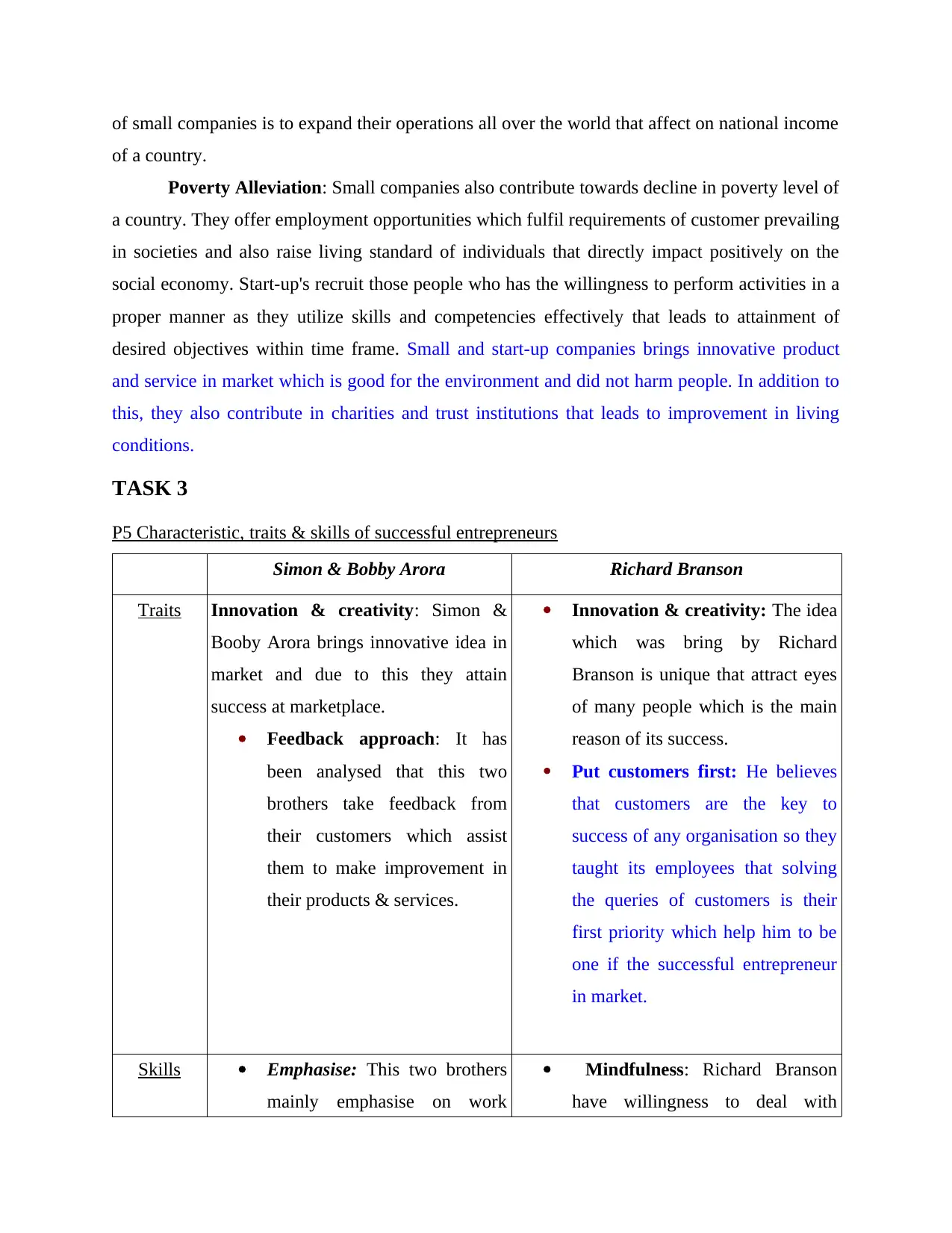
of small companies is to expand their operations all over the world that affect on national income
of a country.
Poverty Alleviation: Small companies also contribute towards decline in poverty level of
a country. They offer employment opportunities which fulfil requirements of customer prevailing
in societies and also raise living standard of individuals that directly impact positively on the
social economy. Start-up's recruit those people who has the willingness to perform activities in a
proper manner as they utilize skills and competencies effectively that leads to attainment of
desired objectives within time frame. Small and start-up companies brings innovative product
and service in market which is good for the environment and did not harm people. In addition to
this, they also contribute in charities and trust institutions that leads to improvement in living
conditions.
TASK 3
P5 Characteristic, traits & skills of successful entrepreneurs
Simon & Bobby Arora Richard Branson
Traits Innovation & creativity: Simon &
Booby Arora brings innovative idea in
market and due to this they attain
success at marketplace.
Feedback approach: It has
been analysed that this two
brothers take feedback from
their customers which assist
them to make improvement in
their products & services.
Innovation & creativity: The idea
which was bring by Richard
Branson is unique that attract eyes
of many people which is the main
reason of its success.
Put customers first: He believes
that customers are the key to
success of any organisation so they
taught its employees that solving
the queries of customers is their
first priority which help him to be
one if the successful entrepreneur
in market.
Skills Emphasise: This two brothers
mainly emphasise on work
Mindfulness: Richard Branson
have willingness to deal with
of a country.
Poverty Alleviation: Small companies also contribute towards decline in poverty level of
a country. They offer employment opportunities which fulfil requirements of customer prevailing
in societies and also raise living standard of individuals that directly impact positively on the
social economy. Start-up's recruit those people who has the willingness to perform activities in a
proper manner as they utilize skills and competencies effectively that leads to attainment of
desired objectives within time frame. Small and start-up companies brings innovative product
and service in market which is good for the environment and did not harm people. In addition to
this, they also contribute in charities and trust institutions that leads to improvement in living
conditions.
TASK 3
P5 Characteristic, traits & skills of successful entrepreneurs
Simon & Bobby Arora Richard Branson
Traits Innovation & creativity: Simon &
Booby Arora brings innovative idea in
market and due to this they attain
success at marketplace.
Feedback approach: It has
been analysed that this two
brothers take feedback from
their customers which assist
them to make improvement in
their products & services.
Innovation & creativity: The idea
which was bring by Richard
Branson is unique that attract eyes
of many people which is the main
reason of its success.
Put customers first: He believes
that customers are the key to
success of any organisation so they
taught its employees that solving
the queries of customers is their
first priority which help him to be
one if the successful entrepreneur
in market.
Skills Emphasise: This two brothers
mainly emphasise on work
Mindfulness: Richard Branson
have willingness to deal with
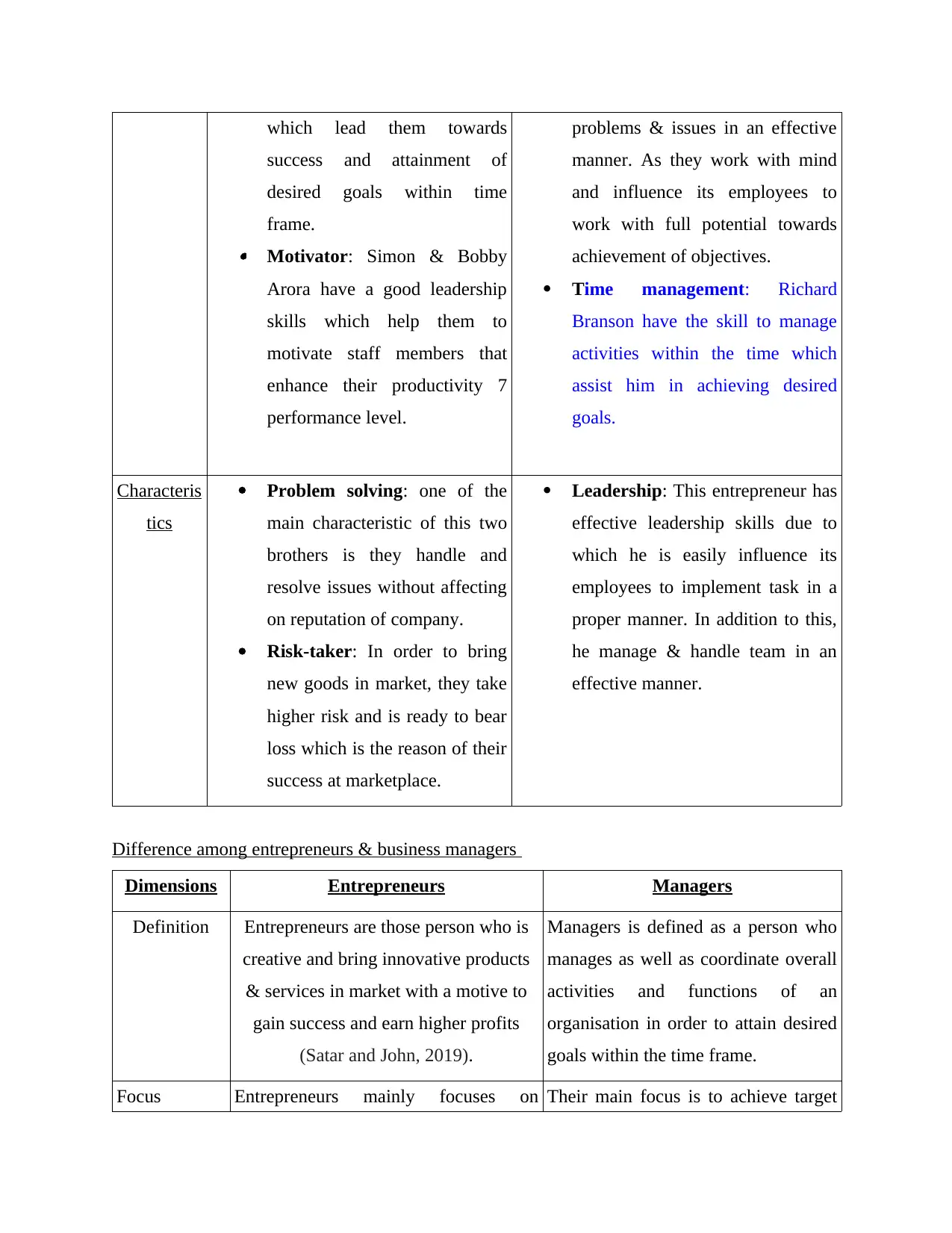
which lead them towards
success and attainment of
desired goals within time
frame.
Motivator: Simon & Bobby
Arora have a good leadership
skills which help them to
motivate staff members that
enhance their productivity 7
performance level.
problems & issues in an effective
manner. As they work with mind
and influence its employees to
work with full potential towards
achievement of objectives.
Time management: Richard
Branson have the skill to manage
activities within the time which
assist him in achieving desired
goals.
Characteris
tics
Problem solving: one of the
main characteristic of this two
brothers is they handle and
resolve issues without affecting
on reputation of company.
Risk-taker: In order to bring
new goods in market, they take
higher risk and is ready to bear
loss which is the reason of their
success at marketplace.
Leadership: This entrepreneur has
effective leadership skills due to
which he is easily influence its
employees to implement task in a
proper manner. In addition to this,
he manage & handle team in an
effective manner.
Difference among entrepreneurs & business managers
Dimensions Entrepreneurs Managers
Definition Entrepreneurs are those person who is
creative and bring innovative products
& services in market with a motive to
gain success and earn higher profits
(Satar and John, 2019).
Managers is defined as a person who
manages as well as coordinate overall
activities and functions of an
organisation in order to attain desired
goals within the time frame.
Focus Entrepreneurs mainly focuses on Their main focus is to achieve target
success and attainment of
desired goals within time
frame.
Motivator: Simon & Bobby
Arora have a good leadership
skills which help them to
motivate staff members that
enhance their productivity 7
performance level.
problems & issues in an effective
manner. As they work with mind
and influence its employees to
work with full potential towards
achievement of objectives.
Time management: Richard
Branson have the skill to manage
activities within the time which
assist him in achieving desired
goals.
Characteris
tics
Problem solving: one of the
main characteristic of this two
brothers is they handle and
resolve issues without affecting
on reputation of company.
Risk-taker: In order to bring
new goods in market, they take
higher risk and is ready to bear
loss which is the reason of their
success at marketplace.
Leadership: This entrepreneur has
effective leadership skills due to
which he is easily influence its
employees to implement task in a
proper manner. In addition to this,
he manage & handle team in an
effective manner.
Difference among entrepreneurs & business managers
Dimensions Entrepreneurs Managers
Definition Entrepreneurs are those person who is
creative and bring innovative products
& services in market with a motive to
gain success and earn higher profits
(Satar and John, 2019).
Managers is defined as a person who
manages as well as coordinate overall
activities and functions of an
organisation in order to attain desired
goals within the time frame.
Focus Entrepreneurs mainly focuses on Their main focus is to achieve target
⊘ This is a preview!⊘
Do you want full access?
Subscribe today to unlock all pages.

Trusted by 1+ million students worldwide
1 out of 16
Related Documents
Your All-in-One AI-Powered Toolkit for Academic Success.
+13062052269
info@desklib.com
Available 24*7 on WhatsApp / Email
![[object Object]](/_next/static/media/star-bottom.7253800d.svg)
Unlock your academic potential
Copyright © 2020–2025 A2Z Services. All Rights Reserved. Developed and managed by ZUCOL.





